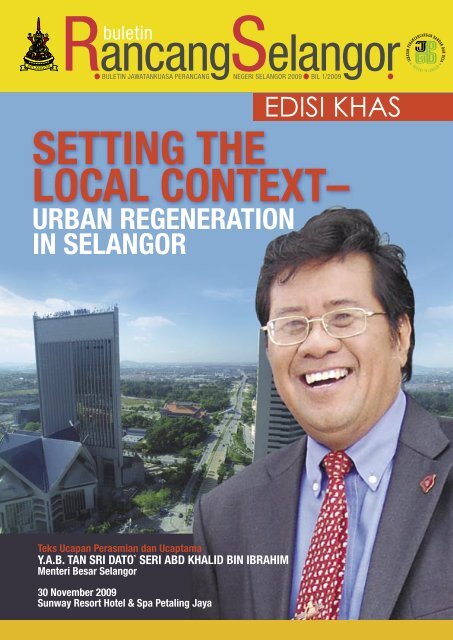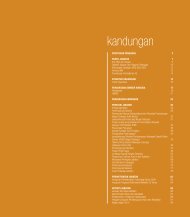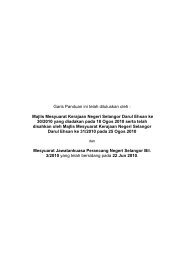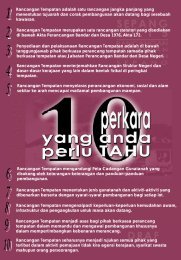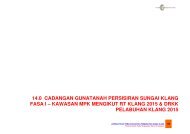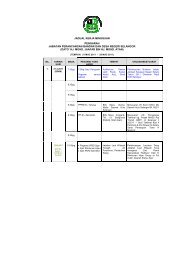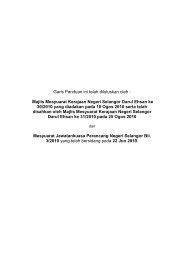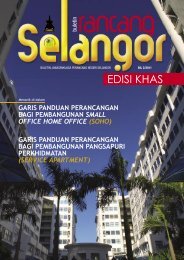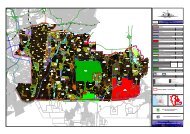Buletin JPBDNS edisi khas 02.indd - JPBD Selangor
Buletin JPBDNS edisi khas 02.indd - JPBD Selangor
Buletin JPBDNS edisi khas 02.indd - JPBD Selangor
- No tags were found...
You also want an ePaper? Increase the reach of your titles
YUMPU automatically turns print PDFs into web optimized ePapers that Google loves.
SELANGOR EDISI KHASSETTING THELOCAL CONTEXT–URBAN REGENERATIONIN SELANGORTeks Ucapan Perasmian dan UcaptamaY.A.B. TAN SRI DATO` SERI ABD KHALID BIN IBRAHIMMenteri Besar <strong>Selangor</strong>30 November 2009Sunway Resort Hotel & Spa Petaling Jayabuletin rancang selangor | EDISI KHAS1
UCAPAN ALUANPENGARAH JABATAN PERANCANGAN BANDARDAN DESA NEGERI SELANGORAssalamualaikum wbt dan Salam Sejahtera,Terlebih dahulu, saya mengucapkan syukur kehadrat Illahi kerana dengan keizinan Nya, maka <strong>Buletin</strong>Rancang (Edisi Khas) ini dapat diterbitkan. Jabatan telah mengambil inisiatif untuk menerbitkan <strong>Buletin</strong>Rancang (Edisi Khas) ini berikutan dari Seminar Antarabangsa Urban Regeneration – Towards <strong>Selangor</strong>’sSustainable Future yang telah diadakan pada 30 November hingga 1 Disember 2009 di Sunway Resort Hotel& Spa, Petaling Jaya.Y.A.B Tan Sri Abdul Khalid Bin Ibrahim, Dato’ Menteri Besar <strong>Selangor</strong> telah menyampaikan Ucapan Perasmiandan Ucaptama yang bertajuk ‘Setting The Local Context – Urban Regeneration in <strong>Selangor</strong>’. Ucaptamatersebut merupakan ucapan dasar yang perlu dijadikan panduan dan halatuju bagi agenda PembangunanSemula Bandar di Negeri <strong>Selangor</strong>. Dalam merealisasikan agenda Negeri ini, semua pihak seperti PihakBerkuasa Negeri, Pihak Berkuasa Tempatan, Agensi/ Jabatan-jabatan Teknikal, Badan-badan Berkanun,pihak Swasta dan lain-lain perlulah menggembling tenaga dan usaha secara bersama. Ucapan perasmiandan Ucaptama ini telah disediakan secara bersama antara <strong>JPBD</strong> dengan Pejabat Menteri Besar. Justeru,<strong>Buletin</strong> Rancang (Edisi Khas) kali ini memaparkan teks penuh Ucapan Perasmian dan Ucaptama Y.A.B Dato’Menteri Besar untuk dijadikan rujukan <strong>khas</strong> bagi merangka dan merencanakan agenda PembangunanSemula Bandar secara jelas sebagai panduan kepada semua pihak yang terlibat.Seminar Antarabangsa tersebut diadakan sebagai salah satu usaha Kerajaan Negeri mengorak langkahkearah Strategi Pembangunan Semula Bandar (Urban Regenaration) yang merupakan salah satu daripadaenam (6) Pakej Rangsangan Ekonomi Negeri <strong>Selangor</strong> yang telah diumumkan oleh Kerajaan Negeri.Akhir kata, saya ingin merakamkan penghargaan pada semua pihak yang terlibat dalam menyediakan<strong>Buletin</strong> Rancang (Edisi Khas) ini dalam masa yang singkat. Yang lebih utama, <strong>Buletin</strong> Rancang yangditerbitkan ini dapat dijadikan rujukan <strong>khas</strong> dan juga sebagai asas dalam merangka halatuju agendaPembangunan Semula Bandar dengan lebih jelas di Negeri <strong>Selangor</strong>.Sekian, Terima KasihMOHD. JAAFAR BIN MOHD. ATANPengarahJabatan Perancangan Bandar dan Desa Negeri <strong>Selangor</strong>15 Disember 20092 buletin rancang selangor | EDISI KHAS
SETTING THE LOCALCONTEXT – URBANREGENERATION INSELANGORByY.A.B. TAN SRI DATO` ABD KHALID BIN IBRAHIMChief Minister of <strong>Selangor</strong>Assalamualaikum wbt and a very good morning,Alhamdulillah, all praise and glory for Allah SWT, for it is with Hisblessings and guidance that we are able to gather here today in thisconference. It is indeed an honour for me to be here this morning todeliver this speech and present this Keynote Paper in this auspiciousConference, where great minds congregate to discuss revitalizingcity development towards a sustainable urban future in the State of<strong>Selangor</strong>.buletin rancang selangor | EDISI KHAS3
1. THE LARGER DEVELOPMENT PICTUREGlobal and National Population Forecasts1.1 First and foremost let me begin with some insights on the global scenario and forecasts for the futureworld population. Figures from the United Nation’s World Population Series corroborates that in 2008,the world population stood at 6.7 billion, an increase of about 83 million from 2007. By 2050, the worldpopulation is expected to increase by 2.5 billion, passing from 6.7 billion in 2008 to 9.2 billion.1.2 At the same time, the population living in urban areas is projected to increase from 3.3 billion in 2008 to6.4 billion in 2050. Thus, the urban areas of the world are expected to absorb all the population growthexpected over the next four decades while at the same time drawing in some of the rural population.(United Nations, 2008)1.3 Most of the population growth expected in urban areas will be concentrated in the cities and townsof the less developed regions. Asia, in particular, is projected to see its urban population increase by1.8 billion, Africa by 0.9 billion, and Latin America and the Caribbean by 0.2 billion. Population growth istherefore becoming largely an urban phenomenon concentrated in the developing world. There will be anincreasingly large population to accommodate in the context of space requirements for economic andsocial activities.1.4 Looking at the picture at home, Malaysia’s population in mid-2009 stood at 28.3 million, and the UnitedNations projects the nation’s population to grow to 40.4 million by 2050. Projections from Malaysia’sNational Physical Plan indicate that the population of Peninsular Malaysia would increase to 26.8 millionin 2020, from a total of 18.5 million in 2000. Peninsular Malaysia’s population would largely reside inurban areas of various levels and categories. While Peninsular Malaysia’s urban population stood at 65.4percent (12.1 million) in 2000, it is expected to increase to 75 percent (20.1 million) in 2020. Spatialrequirements for urban and city development would thus continue to be a challenge to meet the needsof the ever increasing population.4 buletin rancang selangor | EDISI KHAS
Pressure on limited urban resources1.5 Cities and towns will expand in size and nature to play very important roles as engines of growth tospur development. Cities are expected to provide economic opportunities, and create conducive socialenvironments for a better quality of life. Cities will grow, evolve and age over time into complex anddynamic systems to meet the needs of evolving businesses, employment, housing needs and lifestylesthrough generations. However, the urban population’s expansion over the last 50 years has placedexcessive pressure upon the limited resources of the environment.1.6 Excessive industrial growth, increased motorized transportation movements and social lifestyleexpectations, contribute to the expansion and continued sprawling of cities’. This gives rise to theexcessive use of energy and carbon burning which affects the environment and the inner cities. Atthe same time, older cities now face deteriorating urban infrastructure and services, inefficient watersupply, sanitation, waste management, and transportation problems as well as worsening environmentalconditions.1.7 Challenges in planning and managing urban and cities development, would therefore escalate in timewhen land for expansion is scarce. Continued sprawling and expansion of cities into valuablegreenfield areas consequently leave areas of inner cities to run down and decay in dilapidatedconditions. This adversely affects the physical, economic, and social environments of inner city areas.buletin rancang selangor | EDISI KHAS5
2. THE DEMAND FOR RENEWAL AND REGENERATIONDynamic approaches in city development2.1 In facing these challenges, planning and managing cities in this context require new and dynamicapproaches. Initiatives and actions to refresh city living and treat cities as living ecosystems, isinevitable. Measures to mitigate and adapt to climate change impacts and fostering the involvementof private sector and civil society in the process of urbanization, is pertinent.2.2 Managing urban issues and development requires integrated approaches in reviving the developmentof cities. The appropriate combination and utilization of smart growth development concepts, mixedand compact cities’ development and transport-oriented developments that revitalize economicgrowth and market attractions, must be explored and implemented. In this context, all areas of citiesand towns must be given attention. While the ‘young’ growth centres are injected with development,the ‘old and once flourishing’ city and town areas must not be left to decay further, but must berefreshed and given new breath.Defining Urban Regeneration2.3 Most often, the definition of urban regeneration is intermingled with urban renewal and urbanredevelopment where urban regeneration is regarded as a part of urban renewal initiatives. TheMerriem Webster dictionary defines Urban Regeneration as “the rehabilitation of deteriorated ordistressed urban areas, by slum clearance and redevelopment construction in housing andpublic facilities”.2.4 However in differentiating them, urban redevelopment is regarded as the physical activity ofreconstructing distressed or dilapidated areas into better environments or simply the ‘destroyold’ and ‘erect new’ perspective in development. Urban regeneration, on the other hand, is acomprehensive programme of land redevelopment with the complex combination of economic,physical planning, management and social considerations. The ‘old’ is enhanced and ‘new’developments are constructed to revitalise the economic growth and the social environments of theselected areas.2.5 Urban regeneration involves rehabilitation efforts of impoverished and derelict urban industrial areasand neighbourhoods by large-scale renovation or reconstruction of housing, public works, commercialuses and mixed developments. These elements of urban regeneration are brought together to improvethe social sustainability, economic viability and the infrastructure of city areas and to help improveurban landscapes.6 buletin rancang selangor | EDISI KHAS
The Urban Regeneration Wave2.6 The modern incarnation of urban regeneration began in the late 19th century indeveloped nations and since then, the process has had major impact on manyurban landscapes, and demographics of cities around the world. Moving awayfrom the traditional demolition, reconstruction and population displacementrenewal schemes, present regeneration efforts are more comprehensivewith the combination of economic, physical, institutional and socialconsiderations for building effective and sustainable environments.2.7 Urban renewal and regeneration is now a pertinent ingredient for buildingsustainable cities. Many success stories of urban regeneration efforts fromvarious developed cities and other parts of the world such as the UK, USA,Australia, Canada, Sweden, Hong Kong, Singapore and South Korea can bebenchmarked to see how concerted efforts have transformed and revitalized cities.Successful examples indicate how derelict brownfields, dockyards, industrialareas, and worn-out city areas are transformed into new, fresh and vibranteconomic centres providing new opportunities and city environments.2.8 Just to name a few examples, for instance in the UK, the high profile constructionof the innovative and exclusive waterside regeneration development at London’sCanary Wharf in the 1980s reflected, in part, the hopes and aspirations ofthe Conservative Government at that time. In London’s Canary Wharf, thetransformation of the once shipping dockyard, has boosted the Docklands intoa major business centre with improved transportation links and an increasinglyacceptable area to live with a ‘more than double’ population figure.2.9 Another UK example, Glasgow, has been transformed from a redundant,dilapitated city of economic decline with high unemployment, urban decay andpopulation decline to a revived economy with its regeneration of inner-city areas,especially the largescale Clyde Waterfront Regeneration, and the GlasgowHarbour Project. The futuristic Glasgow Harbour regeneration project is one ofthe largest waterfront regeneration projects in the UK. The city now resides in theMercer index of top 50 safest cities in the world and is considered by Lonely Planetto be one of the world’s top 10 tourist cities.LondonGlasgowbuletin rancang selangor | EDISI KHAS7
Melbourne Docklands, Australia2.10 From Down Under, the Melbourne Docklands, Australia, is another regenerationexample. The area, once used for docks, rail infrastructure and industry, mostlyfell out of use, vacant and unused during the 1980s. Urban renewal began in 2000and now the project boasts wide open water promenades and road boulevardswith contributions of landscaping and public art commissions. The MelbourneDocklands has become a sought after business address attracting multinationalcorporate businesses.2.11 Urban regeneration in Cheongyecheon, Seoul, South Korea is a “back tonature” initiative. The renewal project involves the restoration of a stream thatwas covered by an elevated highway which was then deteriorating and posedsafety problems. The project was aimed at revitalising the economy of the Seoulmetropolis and to become a human-oriented and environmental-friendly city.The urban renewal project was the catalyst for revitalizing downtown Seoul,transforming Cheongyecheon into the centre of cultural and economic activities.Cheongyecheon is today a popular site among Seoul residents and tourists.Cheongyecheon, Seoul8 buletin rancang selangor | EDISI KHAS
2.12 Malaysia has her fair share of redevelopment efforts that have takenplace over the years. Back home in Kuala Lumpur, perhaps oneof the most prominent redevelopment projects in the country is thetransformation of the former <strong>Selangor</strong> Turf Club area in Jalan Ampangto the Kuala Lumpur City Centre (or better known as KLCC) wherethe tallest Twin Towers stand.2.13 Another admirable project is the transport-led urban regenerationefforts of the KL Sentral as Kuala Lumpur city’s transportation hub.The project represents a vivid transformation of the Brickfieldsneighbourhood into a more promising local economy and creatingdevelopment opportunities and impetus for growth in the area. It isclear that the transformation of Brickfields from an ethnic residentialand commercial enclave to a cosmopolitan hub is linked to therailway-linked regeneration effort.2.14 And we are most fortunate that this two-day Conference will enrichus further with the experiences of more regeneration efforts from thecities of Washington DC, Brisbane, Singapore, and local experiencesof Georgetown and Sentul Raya from knowledgeable guests andspeakers.<strong>Selangor</strong> Turf ClubKL Sentralbuletin rancang selangor | EDISI KHAS9
3. DEVELOPMENT IN THE LOCAL CONTEXTOF SELANGOR<strong>Selangor</strong> – position and contribution3.1 The State of <strong>Selangor</strong> is Malaysia’s most populous state where the nation’s biggestconurbation, the Klang Valley, is situated. In 2008, <strong>Selangor</strong>’s population was 5.07million, increasing from 4.1 million in 2007. The <strong>Selangor</strong> State Structure Planprojects the population of <strong>Selangor</strong> to grow by 2.9% to 7.3 million in 2020. InMalaysia, <strong>Selangor</strong> is the state with the highest net in-migration, recording a9.5% net in-migration in 2003 as compared to Kuala Lumpur’s net out-migration of28.9%. <strong>Selangor</strong> State is also the nation’s most urbanized state where more than88% of her population is urban. This is expected to increase to 90% by 2020.10 buletin rancang selangor | EDISI KHAS
3.2 In terms of economic contribution to the development of the country, <strong>Selangor</strong>’sshare to the nation’s Gross Domestic Product (GDP) is about 21% (2007), withsubstantial shares in the manufacturing sector as well as the transport,storage and communications sector, at 40% and 33.1% respectively (2007).<strong>Selangor</strong>’s labour force participation rate (LFPR) was 66.5% in 2000. The labourforce participation rate of <strong>Selangor</strong> is expected to increase to 70.7 % in 2020with about 2.8 million workforce. This shows a large availability of working agegroup and essential workforce to boost the development of the state, besides itsexpected in-migration.3.3 <strong>Selangor</strong>’s geographical position in the centre of Peninsular Malaysia contributesto the country’s rapid development as Malaysia’s transportation and industrialhub. As a State enveloping the city of Kuala Lumpur, many of <strong>Selangor</strong> citieshave developed to accommodate the sprawl and overspill developmentand population growth of the national capital. This has provided immense jobopportunities and attracted local migration as well as migrants from other statesand overseas. In recent decades, the influx of immigrants has further contributedto <strong>Selangor</strong>’s population.<strong>Selangor</strong> cities and arising issues3.4 The major urban centres in <strong>Selangor</strong> are Petaling Jaya (2008 urban populationof 261,000 persons), Subang Jaya (315,400 urban population), Shah Alam(258,300 urban population), Ampang Jaya (574,300 urban population), Kajang(356,800 urban population) and Klang (617,500 urban population). The populationof these urban centres are mostly concentrated in the operational areas of themunicipalities, recording high population densities. For instance, the AmpangJaya Municipality has the highest density of 108.32 persons per hectare, followedby Petaling Jaya Municipality with 55.66 persons per hectare. The Subang JayaMunicipality has a density of 33.78 persons per hectare, Kajang Municipality with31.82 persons per hectare, Shah Alam and Klang with 15.21 and 14.11 personsper hectare. Due to the economic opportunities and location, <strong>Selangor</strong> cities nowplay prominent roles in the flourishing developments of the Klang Valley.3.5 The high rate of development and population increase in the State bringschallenges which need to be tackled. While the lack of clear urban limits has led tourban sprawl encroaching upon environmentally sensitive and major agriculturalareas, the inner city areas face issues of decline in quality of living. Substantialparts of the aged inner city areas are now less competitive in urban economies,have inefficient transportation system, inefficient infrastructure supply, insufficientcommunity services, lack of emphasis on urban design and heritage conservationand are also degrading environmental quality. This demands attention and action.3.6 The increase in development demands new economic priorities, job opportunities,efficient transportation linkages, renewed areas for housing, social amenities,commercial and other urban landuses. Thus, while preserving agricultural andenvironmentally sensitive areas, cities and towns of <strong>Selangor</strong> require combinedapproaches of redevelopment and revitalization of its old and ageing cities intofresh and vibrant economies with environment-friendly and energy-saving featuresfor achieving sustainability.buletin rancang selangor | EDISI KHAS11
Aspiration for a Sustainable Future3.7 Sustainable Development has always been the ultimate agenda of the Government of <strong>Selangor</strong>to ensure the development in the State is geared towards achieving a balanced and sustainablefuture. The principle of Sustainable Development is upheld in <strong>Selangor</strong>’s Sustainable Developmentpolicy and Agenda 21 with its integration into decision-making, formulation of policies, laws andregulation. Principles of Sustainable Development is further translated into the <strong>Selangor</strong> StateStructure Plan in guiding the physical landuse policies of the state.3.8 The <strong>Selangor</strong> 2025 Development document (Laporan Hala Tuju Pembangunan Negeri <strong>Selangor</strong>2025), sets out the State policy for building sustainable communities of high culture and morale,addressing socio-economic imbalance, strategic urban and landuse directions, and preservingsustainable environments. For a sustainable future, by 2025 the State’s landuse share foragriculture areas and forests must be preserved at 30 percent each, while 2.1 percent shallbe retained for water body and waterways, leaving only 37.93 percent for built up areas. Thisshall require the control of urban activities encroachment into agriculture and forests areas. Thus,the renewal and redevelopment of inner cities which are ageing and decaying, is not an option butis now a neccessity in <strong>Selangor</strong> to foster further economic and social development of the State. Todate, the towns of Petaling Jaya, Klang, Ampang and Kajang have been identifi ed as appropriatelyin need of regeneration initiatives.<strong>Selangor</strong> – Future Landuse12 buletin rancang selangor | EDISI KHAS
Historical growth and development of towns3.9 Perhaps it would be appropriate for me to briefly recollect the earlydevelopments and growth of the older cities of <strong>Selangor</strong> that are in need ofregeneration. As for Petaling Jaya, its development commenced in 1952as an answer to the problem of overpopulation in Kuala Lumpur. PetalingJaya has since witnessed a dramatic growth in terms of population sizeand geographical importance. It started with the construction of 800 housescentered around the area currently known as “Old Town” today, later with thedevelopments of PJ South and PJ North. Petaling Jaya progressed rapidly dueto the massive rural-urban migration, developing more areas in Sungai Wayand Subang districts along with new areas such as Subang Jaya and Section52. Manufacturing in Petaling Jaya has declined or many wish to relocateto areas with lower land prices for expansion purposes; so many industrialareas in PJ are not suitable anymore. In this case, the main purpose of urbanrenewal is to deliberately change the urban environment and to inject newvitality through planned adjustment of existing areas to respond to presentand future requirements for urban living and working.3.10 Eventually, in a boundary realignment exercise in early 1997, parts of PetalingJaya such as Subang Jaya, Sunway, Puchong and USJ were placed underthe jurisdiction of the then newly formed Subang Jaya Municipal Council orMPSJ. The Petaling Jaya Municipality today covers an area of 97.2 squarekilometres with a population of about 600,000 persons.3.11 The royal town of Klang has been a site of human settlement with strongconnections to the Malacca Sultanate leading to the establishment of the<strong>Selangor</strong> Sultanate in the 18th century. In the 19th century the importance ofKlang greatly increased by the rapid expansion of tin mining as a result of theincreased demand for tin from the West. Today Klang is no longer the Statecapital or the main seat of the Ruler, but it remains the headquarters of theDistrict to which it gives its name.3.12 Other fast developing areas in <strong>Selangor</strong> include the towns of Kajang andareas of Ampang. Kajang as a modern town owes its rise in particular tothe coffee estates which were opened up around it in the 1890s. Kajangwas later known as the famous ‘satay town’ with various development areasopened to accommodate thriving business activities. Ampang is a suburbof <strong>Selangor</strong>, and was previously a tin mining town located in the districtsof Hulu Langat and Gombak. Ampang now houses large businesses andhousing developments. Ampang is also the home to many Koreans and otherexpartriates.KlangKajangbuletin rancang selangor | EDISI KHAS13
4. GEARING FOR LOCALREGENERATION EFFORTS4.1 Beginning as vibrant economic centres for the State, overthe years the older towns in <strong>Selangor</strong> have aged and are notfunctional to meet present-day needs and challenges. Urbanrenewal and regeneration is thus, needed to replan andtransform the old urban and industrial areas of PetalingJaya, Klang, Ampang Jaya and Kajang to revitalizeeconomic activities, provide better transportationlinkages and infrastructure for enhanced and efficientsocial environments. Urban regeneration is a complexcombination of social, economic, planning, construction andmanagement activities;Section 134.2 In translating the policies from the State Structure Plan,the Local Plans for these municipalities have earmarkedthe appropriate areas for redevelopment in these towns.All in all, an approximate total of 2,375 hectares havebeen identified in the Local Plans and Draft Local Plans ofPetaling Jaya, Klang, Ampang Jaya and Kajang which areripe for and in need for regeneration and redevelopment.4.3 Approximately, a total of 1,672 hectares are areas inPetaling Jaya, namely the industrial, commercial andresidential areas of Sections 13, 51, 51A and 52.Section 51 & 51ASection 52Petaling Jaya14 buletin rancang selangor | EDISI KHAS
4.4 Klang has an approximate total of 131.4 hectares in need of redevelopment,especially the Klang town centre and Kampung Pandan of Klang, besides thebanks of the Klang River.4.5 Kajang has an approximate area of 412.4 hectares identified which are thetown centre and Sungai Ramal areas while 159.3 hectares have been identifiedin Ampang Jaya covering the areas of Ampang New Village, residential areasin Jalan Jelatek, Taman Keramat ( or better known as the Colombia Flats) andtraditional villages in Kampung Pandan Dalam.KlangKajangAmpangbuletin rancang selangor | EDISI KHAS15
Regeneration – the State’s Agenda4.6 Following this need, I am more than pleased to reiterate that redevelopment ofurban areas is one of the six <strong>Selangor</strong> Government’s Economic Stimulus Packagethat has been announced recently. The stimulus package, which includes therehabilitation of the Klang River and enhancing the transportation system, isexpected to generate an estimated RM10 billion in investments. The urbanregeneration and redevelopment programme is aimed at revitalizing the towns,creating job opportunities, enhancing the quality of life, improving amenities andinfrastructure, improving management of the state assets as well as generatingmore revenue for the state and local governments.Setting the Local Context4.7 We realise and are aware that implementing this effort on regeneration in the Stateshall not be an easy task. Mechanisms for preparing the appropriate developmentplans, refining the legal aspects, stakeholders’ consultation and institutionalizingthe implementation authority to undertake and implement the effort shall have tobe carefully planned. The State Government is committed and determined in thisventure and has embarked on initial moves towards this.4.8 Consultants and experts have been appointed to work along with the StateEconomic Planning Unit, State Town and Country Planning Department and theLocal Authorities to study and identify actual sites for regeneration and to suggestpriorities in developing them. A Special Committee has been appointed to overseethese studies and actions for the regeneration efforts. For the Klang area, theredevelopment of the Klang River is of priority. The State is now undertaking alanduse study to inventorize development along the banks of the 21 kilometresKlang River alignment in the Klang, Shah Alam, Subang Jaya and Petaling JayaMunicipalities.4.9 From the legal perspective, the State intends to prepare development plansthrough the Special Area Plan mechanism as stipulated in the Town and CountryPlanning Act, 1976 (Act 172). We also understand that other related legislationsthat may have implications shall have to be studied, updated and coordinatedalong the way.4.10 From the institutional perspective, experiences of Hong Kong and Singaporeindicate the necessity for establishing appropriate implementing bodies tospearhead renewal projects. Hong Kong and Singapore have Urban RenewalAuthorities established while regeneration in Melbourne Docklands is throughthe existing agency of its State Government of Victoria. In South Korea theSeoul Metropolitan Government established the Cheongyecheon RestorationProject Headquarters and Cheongyecheon Restoration Research Corporation forestablishing and review of the restoration plan for the Cheongyecheon streamrestoration.16 buletin rancang selangor | EDISI KHAS
4.11 In terms of funding, experiences of successful regeneration effortsdemonstrate that urban regeneration is most effective when it is delivered inpartnership with those groups and organisations best placed to influence thesuccess of urban regeneration projects. The initiative for private funding orjoint public-private funding is essential. This means that Government and LocalAuthorities would work in partnership with construction companies, privatesector organisations and local communities.4.12 From the social perspective, consultation with local communities abouturban regeneration plans has been recognised as being vital to the project’ssuccess. This is because urban regeneration has direct links to, and affectsdirectly, the communities living in the areas where regeneration is planned.As a consequence, community regeneration is an integral part of urbanregeneration. Successful urban regeneration will not only work at the physicallevel but will result in the building of successful, viable, vibrant and sustainablecommunities. In <strong>Selangor</strong>, perhaps a Citizen’s Committee could be formedlike in Korea, in order to emulate the experiences of successful projects fromabroad.4.13 The State is determined that renewal efforts shall involve social inclusionof stakeholders into redevelopment efforts. Initial plans under discussionhave touched on aspects of provision of affordable housing for low incomehouseholds, micro-financing schemes for qualified low income individualsto ensure their direct involvement in development of urban slum areas, theimprovement of IT infrastructure and broadband penetration and to enlargeregeneration areas into mini-city centres. These areas can then be transformedinto hubs of economic activity for business, education and social activities aswell as enhancing growth small and medium enterprises (SMEs) in these areas.4.14 I would suggest that the possible approaches to neighborhood regenerationcan therefore be identified as: (i) redevelopment, wherein a neighborhood isrebuilt anew; (ii) rehabilitation, wherein the existing structures are preservedand upgraded; (iii) and integration, a combination of the first two approaches.Each approach can involve the re-housing of the population on the original siteor its relocation to another part of the city.4.15 In terms of redevelopment, for developers, redevelopment representsmaximum profit through the sale of new centrally -located units. For localgovernments, this approach represents maximum use of land, higher floorarea ratio, and has the advantage of introducing higher income groups andcommercial activities to the city center, which increase tax revenues. It alsoleads to higher population density and improved services and infrastructures,which is highly desirable for modernizing inner-city areas.Redevelopmentbuletin rancang selangor | EDISI KHAS17
Rehabilitation4.16 However, this approach may carry heavy social and environmental costs. Thedemolition of architectural environments is probably the most serious consequenceof the redevelopment approach. It can bring about the sacrifice of a community’scultural heritage and the destruction of viable neighborhoods. Redevelopmentgenerally involves the relocation of the original population to another part ofthe city. Even when the residents are re-housed on the same site after itsredevelopment, the transformation of the neighborhood beyond recognition hasinevitable psycho logical impacts upon the community.4.17 For rehabilitation, often termed as conservation or preservation, is seen as theopposite of redevelopment. It is based on preserving, repairing, and restoring thenatural and man-made environments of existing neighborhoods. Rehabilitation isapplicable to areas where buildings are generally in structurally sound conditionbut have deteriorated because of neglected maintenance.4.18 In developing countries, upgrading generally refers to a comprehensivedevelopmental approach wherein the original population remains on the site andincrementally upgrades the neighborhood, with or without public assistance. Bytreating the resident population as an active force in the housing process, thisapproach generates a greater pride in the neighborhood and halts the impendingdeterioration caused by a lack of investment and environmental concern.Rehabilitation is often perceived as a complex and time-consuming process whichis more difficult to implement than redevelopment. It requires a high degree ofsocial organization and social responsibility, as well as a total reorganization of thehousing process.4.19 The third approach to neighborhood regeneration, which referred to asintegration, views redevelopment rehabilitation as complementary forces andcombines the best aspects of both approaches. It consists of rehabilitation of whatcan realistically be saved, combined with reconstruction of new buildings in placeof those beyond the reach of feasible rehabilitation.Integration4.20 Today, we consider integration as the most acceptable way to regenerate oldneighborhood. It allows for flexible project implementation which can preserve thetraditional urban environment and its human scale while achieving respectabledensities. It respects the social order of the community by re-housing the majorityof the original residents on the site and invites mass participation. Integrationresults in the creation of rich environment through the integration of new buildingswithin the existing neighborhood and allows for the development of a new form ofcontemporary architecture with local characteristics, enriching the appearance ofthe old city while maintaining its identity.18 buletin rancang selangor | EDISI KHAS
5. CONCLUSION5.1 Our road map towards implementing these regeneration efforts is still a long way ahead. Infact,our efforts have just begun. The organizing of this conference is a step forward in the process ofconsulting and gathering more ideas from the experts, professionals as well as the public. We willdefinitely embark on more consultation and provide more channels for proposals and suggestionsfrom the communities and stakeholders. The <strong>Selangor</strong> State Government is determined thatregeneration efforts in the state shall consider and pay attention to issues from all perspectives toensure projects are planned and implemented tactfully and coherently.5.2 Finally, it is without doubt that, ultimately the successful implementation of these regenerationefforts shall lie on the effective cooperation and collaboration of all parties that are directly andindirectly involved in this strategy. As the head of government for the state, I believe that we are onthe right track in moving towards the aspirations of <strong>Selangor</strong> as ‘a dream State’ (negeri idaman)for all. As we drive development efforts in new areas as well as revitalize old inner cities, weaddress development in a coherent manner, complementing each other towards quality living andsustainability. And I am confident that with sincere and concerted efforts from all parties, we cantogether work towards building a sustainable future for the State of <strong>Selangor</strong>.Wabillahitaufik wal hidayah wassalamualaikum wbt.Thank You.buletin rancang selangor | EDISI KHAS19
ResolutionWe, the participants of the International Conference on Urban Regeneration – Towards <strong>Selangor</strong>’sSustainable future, over two days, from 30 th November 2001 to 1 st December 2009, hereby make thefollowing recommendations to the State Government of <strong>Selangor</strong>:1. That we agree with the policy of Urban Regeneration for the inner cities of <strong>Selangor</strong> and hat UrbanRegeneration be one of the economic stimulus of he State Government;2. We urge that there be strong continuous leadership and clear vision by the State and LocalGovernment to implement the policy of Urban Regeneration for the benefit of the Public first interms of access to employment, housing, recreation, commerce, leisure and religious needs for allsectors of the community;3. That the State and Local Government engage local communities in all efforts of Urban Regenerationand practice a transparent process at all levels;4. We strongly urge that there may be smart partnerships between Government at all levels,Businesses and the Community in finding and ensuring a balance between social, economic,physical, spiritual and environmental needs for city development and regeneration;5. The Government set up a special vehicle with stakeholders’ involvement within the next twoyears to ensure that Urban Regeneration Strategies are implemented holistically, efficiently andcomprehensively;6. That we, as members of the community from all sectors, are willing to work together with thegovernment to ensure the success of the policy of Urban Regeneration in order to make our townsand cities vibrant, livable, safe and comfortable for all.7. We ensure that we too, aim for sustainable urban growth and share the concerns of the StateGovernment to address many of the urban issues faced in the State.Thank You.All participantsOf the International Conference of the Urban Regeneration –Towards <strong>Selangor</strong>’s Sustainable Development30 th November & 1 st December 2009Prepared by <strong>JPBD</strong> <strong>Selangor</strong>with the cooperation from the Office of the Chief Ministerwww.jpbdselangor.gov.myJabatan Perancangan Bandar Dan Desa Negeri <strong>Selangor</strong>Tingkat 15-18, Bangunan Darul Ehsan, No. 3, Jalan Indah, Seksyen 14, 40646 Shah Alam, <strong>Selangor</strong>


